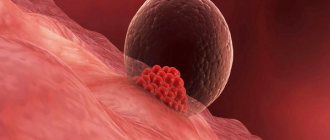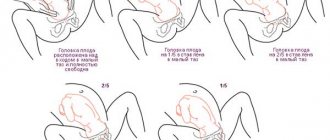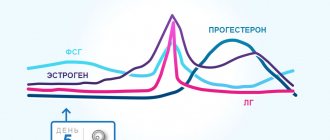Home > Medicine > After ovulation, pulling in the lower abdomen and lower back
Medicine
Your couple carefully planned the pregnancy. You followed all the doctors' orders, passed all the necessary examinations and led an active sex life. But the most important question remains valid: how to recognize whether fertilization has occurred or not?
In fact, a woman’s body gives us many clues when conception occurs. Maybe there was no release of the egg, but life is already developing in the uterus? It is important to “read” the hints correctly. And if you feel a nagging pain in the lower abdomen, perhaps there is a reason for joy. After all, almost all women feel pain after ovulation as a sign of pregnancy.
Of course, you yourself cannot give a 100% guarantee that everything worked out and the baby is already there. It is necessary to exclude the possibility that the pain is due to an existing disease. To do this you need to visit a specialist. He will examine you and order some tests. This will help you figure out whether you have succeeded or whether you need to repeat everything all over again.
Can pain after ovulation be a sign of conception?
One of the main clues to pregnancy is pain that appears approximately 4 days after ovulation. Almost all ladies notice that the ovary begins to hurt. You may also experience discomfort in the lower back or in the uterine area.
Pain during ovulation begins to become more severe after 6-7 days. This period is the most favorable for implantation and it is most active. These sensations will last from one hour to one day. During this period, a woman may see a couple of drops of blood on her underwear , which can be mistaken for menstruation. This is wrong. In fact, this process is called implantation bleeding. It appears as a result of the fact that a fertilized egg is attached to the wall of the uterus. This means that fertilization was successful.
Possible causes of pain after ovulation
One of the most common causes of pain in the lower abdomen and lumbar region after the release of an egg is pregnancy. The pain appears due to the rupture of blood vessels in the walls of the uterus, which occurs at the time of attachment of the embryo. The intensity of the pain depends on the woman’s sensitivity and pain threshold. Some feel only a slight tugging in the lower abdomen, which goes away after 1-2 days. Women with a low pain threshold may experience severe nagging pain that radiates to the lower back and continues for 5-7 days after ovulation. After a week, the symptoms usually subside and make themselves felt again after 7-10 days, when the woman notices that she has a delay.
Pregnancy is the most common cause of nagging pain in the lower abdomen and lower back after ovulation
Pain after ovulation, which occurs due to pregnancy, is usually accompanied by the following symptoms:
- severe breast tenderness (a woman cannot sleep on her stomach and experiences pain when trying to roll over to the other side);
- increase in the size of the mammary glands;
- slight bleeding (literally a couple of drops);
- temperature rise to 37-37.3° (lasts for several days).
Important! The listed symptoms may be absent, even if the fertilized egg has already attached to the walls of the uterus, so it is impossible to diagnose pregnancy only by these signs at this stage.
Ovarian injury
Injury to the ovaries is one of the most common causes of pain after ovulation.
This is one of the most common causes of pain after ovulation. If the walls or tissues of the ovaries and fallopian tubes are damaged, strong pulling sensations appear, which can radiate to the lower back. The pain can take on a stabbing character and intensify with movement or any stress. Any negative factors can lead to a violation of the integrity of the ovarian walls, which include:
- lifting objects with heavy weight;
- too active movements of the partner during intimacy;
- increased physical activity (for example, related to professional activities).
Severe stress and anxiety increase the likelihood of injury, since under the influence of hormones released in large quantities during emotional stress, organ tissue softens. In this case, an ultrasound of the pelvic organs will help to accurately determine the cause of the pain.
Ovarian cyst rupture
Schematic representation of an ovary with a cyst
Cysts are the most common complication in the functioning of the reproductive system. A cyst is a cavity in the ovarian tissue that is filled with serous contents. Most often, women have follicular cysts (formed at the site of a follicle rupture) and corpus luteum cysts. Education can grow for several months without showing itself in any way. When the cysts reach large sizes or become inflamed, pain appears in the lower back or the sides of the lower abdomen. The cyst is removed using laparoscopy. If this is not done in time, the cyst may rupture, and its contents enter the abdominal cavity, which is fraught with the development of peritonitis, sepsis and other serious pathologies, so it is necessary to consult a doctor if the pain does not go away within 2 days after ovulation.
Inflammatory processes in the pelvic organs and genitourinary system
Another reason for pain after ovulation is inflammatory processes. Inflammation occurs under the influence of bacteria and microbes that enter the mucous membranes of organs and actively multiply there. In some pathologies, pain will appear only in the lower abdomen (for example, with cystitis - inflammation of the bladder), but sometimes it can occur in the lumbar region. This clinical picture is observed with pyelonephritis or glomerulonephritis.
Symptoms of pyelonephritis
Inflammatory processes of the genitourinary system are accompanied by other symptoms that cannot be ignored. These include:
- temperature increase;
- painful and frequent urination;
- darkening of urine and formation of sediment in it;
- the appearance of streaks of blood in the urine.
The reproductive organs can also become inflamed: the uterus, appendages and ovaries. The pain can radiate to the tailbone, lower back and even buttocks. The intensity of pain is usually high. Character – sharp, shooting. To prevent the progression of pathologies and serious complications, it is necessary to go to the hospital in a timely manner.
Intestinal problems
Some women make a serious mistake when, when pain appears, they try to drown out the discomfort by taking analgesics or begin treatment on the advice of friends and acquaintances. Most diseases may have similar symptoms, but the treatment required is completely different, so you should take any medications only after consulting a doctor.
Symptoms and causative agents of colitis
Nagging pain in the lumbar region, as well as in the lower abdomen, which appeared 5-7 days after ovulation, may indicate inflammation of the intestines - colitis. The disease is typical for women 20-35 years old. Hormones that are released in large quantities during ovulation dull the symptoms of the inflammatory process, so pain occurs a few days after the release of the egg into the fallopian tube, when the hormonal background stabilizes.
Important! To treat colitis, a woman will need to take anti-inflammatory drugs selected by a specialist and a strict diet. Dietary restrictions are necessary during the acute stage, so as not to aggravate the course of the disease and not to injure the inflamed mucous membrane with rough food.
Video - Where does pain in the lower abdomen come from in women?
Malignant processes
Cancerous tumors can appear at any age. The lesion can affect any organ. In women, the reproductive system is the most vulnerable. In the presence of nagging pain that does not go away within 7-14 days after ovulation, cancer is diagnosed in one woman out of 10,000. This is not a very high figure, but this possibility cannot be excluded. If a malignant process begins in the body, other symptoms may appear that are usually not paid attention to. These include:
- increased mucous secretions;
- the appearance of blood streaks in the mucus;
- temperature fluctuations;
- headaches and general malaise.
Important! At the initial stage, when the tumor is just beginning to grow, the cancer has no symptoms, so it is important to undergo a full examination at least once a year. Women over 45 years of age should be examined once every six months, since during this period the susceptibility to oncological processes increases.
Appendicitis
Symptoms of appendicitis in an adult
Inflammation of the appendix is a serious pathology that can lead to serious complications. The main symptom of appendicitis is a dull nagging pain in the abdomen, which can radiate to a variety of parts of the body: lower back, back, arm, forearm and the area between the shoulder blades. When the pathology enters the stage of inflammation, the pain becomes diffuse and it becomes impossible to determine its location. A characteristic feature of appendicitis is the posture that the sick person takes. To reduce pain, the woman lies on her left side and pulls her legs bent at the knees towards her stomach (“fetal position”). If you palpate the abdomen in this position, pain will be detected after pressing on the area where the appendix is located.
Important! If you have symptoms of appendicitis, you should not take analgesics before seeing a doctor, since pain relief can confuse the clinical picture of the pathology and make diagnosis difficult.
Pain after ovulation is a physiological phenomenon caused by the processes occurring in the female body during the release of the egg and ovary. If the pain is of moderate intensity and does not bother you for more than 48 hours, there is no reason to worry. But if the pain does not go away and intensifies, and there are also symptoms that may be signs of other diseases, you need to see a doctor as soon as possible.
What kind of pain can be observed in the first days/weeks of pregnancy?
Pregnancy is a very serious period. And the female body is preparing for it, going through many changes, both at the physiological and hormonal levels. Many of them are experienced very painfully by expectant mothers.
- Lower back pain.
- Headache. When hormones rage, neurological symptoms change dramatically. Therefore, a pregnant woman may constantly complain that she often has a headache.
- Painful ovulation. The very first signal that indicates successful conception.
Some patients come to the doctor with complaints as soon as they feel discomfort in the abdomen. They do not yet know about their “interesting situation.” The thing is that pain can be provoked by just microscopic damage to the mucous membrane or blood vessel. A couple of drops of blood may also be normal.
The stomach can also hurt due to changes in hormonal levels. This all happens because more of the hormone progesterone appears in the blood.
Another unpleasant sensation is caused by the fact that the ligaments are stretched and the center of gravity changes. These symptoms are not harmful, and you do not need to see a doctor because of them. But if you want to calm down and exclude the possibility of diseases or infections, a trip to the hospital will not be unnecessary.
Causes
The abdomen may hurt after unprotected sexual intercourse, both due to normal muscle strain in the abdomen and genitourinary system due to an unsuccessful choice of posture and other factors, and due to the formation of dangerous diseases.
This depends on the symptoms that accompany pain in females after sexual intercourse. There are a large number of provoking factors for such pathology.
To establish the initial cause of discomfort, it is necessary to carry out appropriate diagnostics. The most common factors:
- Defloration. Fear during sexual intercourse provokes contraction of the vaginal muscles, which can cause pain.
- Vaginismus. When one sexual experience is unsuccessful, a woman develops a subconscious fear, which provokes muscle spasms, which leads to the impossibility of full coitus.
- Disorder of the integrity of the hymen. When sexual intercourse is not the first, and the stomach pulls as during the 1st time, the hymen was probably not completely torn. In some cases, virginity in the anatomical sense can be completely broken only during childbirth.
- Inflammatory process. Inflammation may be indicated by unpleasant itching, burning sensation, pain, dryness inside the vagina during or after sexual intercourse. In this situation, it is necessary to diagnose the presence of sexually transmitted infections (candidiasis, gonorrhea). During the treatment period, it is necessary to limit your intimate life and be sure to protect yourself through contraception.
- Spikes. They are formed as a result of an inflammatory process in the intestines or appendages. The presence of adhesions is diagnosed in half of women of reproductive age. Basically, there are no pronounced symptoms, but they appear during coitus. It is necessary to undergo a therapeutic course and choose the most comfortable positions for sex.
- Ruptures or injuries after surgery and childbirth. The issue is resolved surgically, by developing intimate muscles and choosing a comfortable position during sexual intercourse.
- Stagnation in the veins. Prolonged abstinence, infrequent intimate life, lack of orgasm lead to painful sensations of a pulling nature in the lower abdomen after sexual intercourse. Over time, such a pathology, even in the presence of regular intimate life, will become a predisposing factor in the formation of dangerous gynecological diseases - endometriosis, ovarian dysfunction, uterine fibroids, mastopathy.
- Endometriosis. It is characterized by painful symptoms, which intensify before the menstrual cycle, spotting after and before menstruation, and discomfort after sexual intercourse.
- Neuralgia of the pelvic nerves. The nerve can become inflamed due to infection, stressful situations, hypothermia, causing acute pain radiating to the lower extremities.
- Anatomical incompatibility of partners.
- Inadequate release of lubricant. It is considered the result of removal of the Bartholin gland, a psycho-emotional barrier (fear of pregnancy, reluctance to have sex) or hormonal disorders (menopause, postpartum period, use of hormonal drugs).
During pregnancy, a woman should be careful about her sex life. Experts do not recommend overly frequent sexual intercourse, in particular when the lower abdomen feels tight after sex.
The reason is that normal postures will become uncomfortable due to muscle changes inside the uterus and vagina, so their contractions provoke discomfort.
Various signs of increasing, lingering discomfort in the lower abdomen after sexual intercourse are a reason to visit a specialist in order to prevent the progression of dangerous gynecological pathological processes.
What other signs of successful conception could there be?
The fetus tries to communicate its existence from the very first days of its existence. There are many of them, you just need to be able to notice them:
- Minor blood loss. They confuse girls who confuse them with menstruation. This symptom does not appear at the same time: it all depends on the structural features of the body. Usually the norm is 6-12 days. You can see drops of yellowish or brownish blood on your underwear. But here you need to be extremely careful - if the process lasts more than 3 days, rush to the gynecologist. Otherwise, there is a risk of involuntary abortion (miscarriage).
- A heaviness appeared in the lower abdomen. Discomfort appears in the pelvic area. These symptoms may appear in the first week. They indicate that the uterus has become hypersensitive, as well as changes that have occurred in it. Each body feels differently. Therefore, all patients named different pain thresholds. But almost all of them stated that during subsequent pregnancies the pain was much stronger.
- The breasts swelled and became more sensitive. This sign is characteristic of one of the stages of baby development. In the first week after fertilization has occurred, the breasts may become hypersensitive. Pain is also considered normal. But this sign is not mandatory. Some ladies claimed that in the first week after the birth of the fetus, no sensations were observed.
- Malaise, general weakness. Problems with well-being and bad mood can often accompany pregnancy. Immunity deterioration is also possible.
- Symptoms:
- slight malaise
- drowsiness
- rapid fatigue
- weakness
- Irregular menstruation (delay). Sometimes it is possible that menstruation occurs in 1 month of pregnancy, since up to 15 days the fertilized egg may not yet reach the uterus. But a repetition in the 2nd month indicates that there is a problem and you need to go to the doctor.
- Toxicosis. One of the first signs signaling that a miracle has occurred.
Pain in the lower abdomen after unprotected sex forum woman ru
If there is no reason to suspect pregnancy, simply taking an over-the-counter pain reliever (such as aspirin, paracetamol, or ibuprofen) may resolve the problem. I can’t say that my stomach hurt, but there was a feeling that it was pulling me down, well, in general discomfort! 4 days is too short; the embryo is fixed 6-12 days after conception. Painful phenomena are typical primarily for young girls (up to 20 years), but can also occur at a more mature age.
This is explained by the fact that the egg matures alternately in the right and then in the left ovary, the working organ and responds with nagging pain. When the lower abdomen hurts after ovulation on days 5–6, it is already beyond the normal range. This is a special iron characteristic only of the female reproductive system, which produces a dose of a hormone called progesterone. The most common sign of early pregnancy is toxicosis: nausea, vomiting, aversion to previously favorite foods, increased fatigue; successful fertilization entails changes in the mammary glands, in which painful sensations appear.
After all, in order to bear and give birth to future offspring, a lot of endurance, strength and health are required. Unfortunately, I’m not pregnant yet, but I agree to all the tests just to give birth to my own little one. Well, these are just the feelings from the moment of unprotected sex. All the signs are still there, now the tummy below is also swollen, like. Built-in video if a lady has a pull in the lower tummy after ovulation.
How does the process that occurs after ovulation look like in case of suspected conception? Thanks to this feature of her own body, it is much easier for a woman to calculate the time suitable for conceiving a baby. But a bath is a contraindication only because it can serve as a prerequisite for a miscarriage, and if there is still nothing (such as bleeding), then there is nothing to worry about. Such a problem after sex without contraception (on Wednesday) pulls the lower tummy, lower back and lower back, approximately.
Interesting: Contraceptives for Women After 50 Years of the New Generation
conclusions
Mother Nature has designed the female body in such a way that it cannot be adjusted to one schedule. He is individual and full of features. And therefore it is difficult to determine when you have achieved success. And although discomfort in the lower back and abdomen is a reason to think, do not rush to rejoice and perceive pain after ovulation as a sign of pregnancy. First, confirm your assumption at the hospital. And after the specialist studies the test results, it will become clear whether to wait for the baby or not.
During certain periods of the menstrual cycle, a woman may experience sensations of a different nature. Pain in the first days of menstruation is considered natural and does not cause concern, but its appearance at other periods of time makes you perplexed and alarmed, such as when, after ovulation, the lower abdomen and lower back are pulled.
Lower back pain after ovulation
The first days after conception: false symptoms
The symptoms listed above are not only harbingers of pregnancy. They can appear with various intestinal diseases, infections, cervical erosion and other diseases of the reproductive system. This includes nausea, bleeding, swelling of the mammary glands, and frequent urination. The results of the hCG test, as well as an ultrasound examination of the pelvic organs, will help you understand everything.
Pregnancy is the most important and responsible period in the life of all women and you need to treat it very carefully, because a new person is born and develops inside.
Video
Nagging pain after ovulation in most cases is considered normal, which is explained by the physiological characteristics of the process and the woman’s menstrual cycle. This pain is reminiscent of the sensations before menstruation: a woman’s lower abdomen feels tight, and cramping pain may appear. If discomfort does not disappear within three days after ovulation or is accompanied by abnormal discharge, fever and other warning symptoms, you should go to the hospital. The cause may be gynecological diseases and pathologies of the genitourinary system, as well as the onset of a malignant process.
If a woman has no health problems, ovulation occurs exactly in the middle of the menstrual cycle. For most women, the cycle lasts 28-30 days, that is, the rupture of the dominant follicle occurs on the 14-15th day of the cycle. In some cases, the cycle can be 26 days or 32-34 days. You can determine the exact date of ovulation using an ultrasound (this method is used during pregnancy planning) or by keeping a basal temperature chart. The second method is less accurate, since the indicators are affected by hormonal fluctuations, endocrine problems and infectious diseases.
The egg matures and prepares for fertilization during the first half of the cycle. For follicle growth to occur, a woman's brain produces FSH. This is follicle-stimulating hormone (follitropin), which is responsible for the functioning of the reproductive system and the maturation of the dominant follicle. On the 14-15th day of the cycle, the follicle ruptures, the mature egg begins to move through the fallopian tubes, where, after meeting the sperm, fertilization occurs.
In place of the burst wall, temporary glandular tissue is formed, which is called the corpus luteum. This gland is responsible for the synthesis of the steroid hormone progesterone, which is necessary for the attachment of the fertilized egg to the epithelial layer of the uterus (endometrium) and the development of pregnancy. If conception has occurred, the glandular tissue disappears after 2-4 months. If pregnancy does not occur, the gland is absorbed by the beginning of the next cycle.
Natural nature of lower back pain
This phenomenon does not occur in 100% of women, but for some it causes quite unpleasant moments. For most, the standard symptoms are:
- variable painful sensations in the ovary, where it occurred and where the corpus luteum is currently forming; minor and manifested in the lower back; breast enlargement and tenderness; vaginal discharge resembling egg white in structure and appearance.
Egg white accompanies nagging pain in the lower back during ovulation
What is the cause of the pain?
To understand the reason for what is happening, let us remember the physiology of the sexual process.
In the first phase of the menstrual cycle, the follicle with the egg grows until it matures completely. The reproductive cell then breaks through the ovarian lining and moves into the fallopian tube. Here contact with the sperm is possible, leading to fertilization and conception. At this time, the level of progesterone in the blood increases, which affects the nature of the cervical mucus, making it favorable for the movement of male germ cells, has an effect on the glandular tissue of the breast, and prepares the lining of the uterus for implantation.
When the egg is released, a small amount of blood enters the abdominal cavity, causing a not entirely pleasant feeling, and the rupture itself is felt as a painful sensation. That’s why some women feel a tightening in their stomach and lower back after ovulation. This is characterized by signs:
- slight nagging pain in the peritoneum (at the very bottom); similar sensations in the ovary area; mild pain in the lower back; kickback to the lower back.
Pain that characterizes the disease
Having studied the comments of women who experience lower back pain after ovulation, we are convinced that the duration of these sensations lasts no more than 48 hours. Each person has a different severity of pain. Some feel only a slight tingling sensation, others have nagging, irritating pain in the front on one side and in the lower back, and still others cannot do without painkillers. This is due to both the woman’s sensitivity to pain and internal processes, which are different for each person.
The continuation of this condition for more than two days requires special attention. If, 4-5 days after ovulation, the lower back is pulled and pain in the abdomen or peritoneum continues to bother you, this indicates a disease:
- inflammation of the bladder (cystitis); inflammation of the ovary; cyst rupture; inflammation of the intestines (colitis).
How long can the pain last?
If the pain does not go away after 2-3 days, then most likely its cause is a pathological factor:
- Cystitis.
- Inflammatory process in the ovary.
- Cyst rupture.
- Intestinal inflammation.
- Salpingitis, endometriosis.
- Appendicitis.
- Inflammation of the abdominal organs, etc.
In case of prolonged painful manifestations, there is no need to hesitate to visit a doctor. Only a specialist can determine the exact cause of pathological symptoms. The pain that is caused by ovulation does not last longer than 3 days, you should not forget about this.
If after ovulation fertilization of the egg by sperm does not occur, all symptoms subside. With ongoing pain in the lumbar region, nagging pain in the abdomen, only a doctor can tell what is the reason for this situation.
Unbearable pain accompanied by bleeding indicates an ectopic pregnancy. The embryo, attached to the fallopian tube, stretches it as it grows, which eventually leads to rupture. In this case, the patient will require surgical intervention.
IMPORTANT: Appendicitis or rupture of a cyst can lead to peritonitis, which can be fatal. If vomiting, nausea, fever, or acute pain occurs, you should immediately go to the hospital.
Pain as evidence of pregnancy
If contact is successful, the fertilized egg moves forward and penetrates the endometrium of the uterus. During implantation, several vessels in the lining of the uterus rupture, which can be felt by some girls. So, if a week has passed since ovulation and your lower back is tightening again, this is most likely an early sign of pregnancy. Additional evidence of the fact at this stage is considered:
- swollen breasts; slight bleeding from the vagina in the form of 1-2 drops of blood; pain is felt on the 7th day after ovulation (pulling the lower back, the bottom of the cavity in the front part hurts).
If, a week after ovulation, the lower abdomen and lower back feel tight, this may be a sign of pregnancy
This means that the embryo has implanted into the endometrial wall. After 1-2 days, all these painful signs disappear and are replaced by the usual, more pronounced symptoms of pregnancy: mood swings, aversion to familiar foods and smells, changes in appetite, mild malaise, etc.
Fertilization: what happens in the body
After unprotected sexual intercourse, sperm rush towards the egg. After a few hours, they merge - this is fertilization. Pregnancy itself can occur only six to seven days after fertilization, when the egg returns back to the uterus. Only after this do changes begin to occur in the body that can be noticed. Before pregnancy occurs, it is impossible to know whether fertilization has occurred.
The first signs of successful conception may appear early or not appear at all. Everything here is individual.
How to find out if fertilization has occurred:
- pay more attention to physical sensations, for example, the perception of products. The most common sign of early pregnancy is toxicosis - nausea, vomiting, aversion to previously favorite foods, increased fatigue;
- successful fertilization entails changes in the mammary glands, in which painful sensations appear. Usually they can be felt two weeks after conception, and they are associated with the body’s preparation for feeding;
- frequent urination, but this can also be cystitis, in which urination is also painful;
- in the first stages of pregnancy, body temperature rises slightly, but not always. Therefore, it is more correct to pay attention to basal temperature, which in pregnant women is always not lower than 37 degrees.
- pulls in the lower abdomen. If the discomfort does not stop within two weeks, it may portend a spontaneous miscarriage;
- Conception is also indicated by a change in the state of vaginal discharge, the amount of which increases. The discharge may be yellowish or brown in color, and mucus may appear;
- fertilization changes the color of the female genital organs. The cervix acquires a bluish color, which is associated with increased blood flow;
- After fertilization, hCG hormones appear in a woman’s body. The principle of pregnancy tests is based on the presence of this hormone in urine.
Long-term pain - what is the danger?
If the pain continues all these days without subsiding: both the lower peritoneum and pulling in the lower back, the reasons for women after ovulation are different and cannot be avoided without an examination by a gynecologist. To do this, you need to establish additional symptoms:
- duration and nature of pain; place of concentration and its strength; pain is typical for each cycle or occurs for the first time; what is the body temperature?
Perhaps the pain is caused by a hormonal imbalance, which will be determined by a blood test for hormones. Most often, unpleasant sensations are observed in the middle of the period, which is caused by ovulation, and before menstruation, as changes occur in the blood supply to the uterus.
A blood test for hormones will help determine the cause of lower back pain
An increase in temperature confirms inflammation of the ovary (with pain radiating to the lumbar region) or fallopian tubes. Lower back pain also appears with osteochondrosis.
Therefore, the doctor must determine the cause after prescribed examinations in each case, based on the analysis and examination data.
And, if the sensations do not go away after the cell comes out after 2 days, or continue to gain strength, do not delay visiting the hospital. The sooner the problem is identified, the faster it will be resolved. Delaying it can only lead to a worsening of the situation.
Symptoms
First of all, the provoking factor of such discomfort should be accurately determined. Basically, not only the lower abdomen begins to hurt, but also the inguinal folds.
Often unpleasant sensations are also observed in the lumbar region. Such symptoms are considered a sign of rupture of a cyst or ovary, which is observed extremely rarely.
In addition, women experience painful sensations after unprotected intercourse, covering the entire lower abdomen and in the process of internal bleeding.
During this period, they can be acute, paroxysmal in nature, and not in all cases are associated with symptoms of external bleeding; there is no bleeding.
The main sign of such a pathological process is acute anemia, if a woman has severe dizziness, blood pressure drops, the skin suddenly turns pale, and fainting occurs.
If painful discomfort in the lower abdomen after sexual intercourse is associated with bleeding, then the woman must immediately contact a specialist, otherwise this will result in adverse consequences, and in certain situations, lead to death.
In particular, you need to call doctors when there is severe bleeding and painful discomfort after or during sexual intercourse, or an injury to the internal genital organs has been caused.
In addition, pain after intimate intercourse is associated with nausea and a gag reflex. In such a situation, in order to eliminate the complexity, it is necessary to consult a specialist.
In addition, the sooner a woman visits a gynecologist, the sooner a positive effect will be achieved to get rid of such a pathology, eliminating the disease at an early stage of formation.
Uterine fibroids are considered one of the provoking factors of unpleasant sensations, since in certain positions during sex, the neoplasm compresses the internal organs and nerve endings adjacent to the uterus, causing discomfort when the penis penetrates deeply into the vagina.
In some situations, the stomach may hurt during unprotected sexual intercourse if the partners are anatomically incompatible.
If sexually transmitted chlamydia and gonococci are present in the cervix, they can cause inflammation and pain, therefore, in order to eliminate them, you should find out the doctor’s recommendations.
In any situation, if discomfort occurs after unprotected sexual intercourse, a woman needs to visit a gynecologist in order to avoid adverse consequences.
What should you remember about low back pain?
In our article, we looked at why the lower back tightens after ovulation and minor pain in the lower peritoneum bothers us. We come to the conclusion that at this moment everything that happens is recognized as the norm and is an explainable physiological process when it is short-term in nature. This is due to a rupture of the ovarian membrane, which may well cause this condition. At a later date (after 7 days), this will most likely indicate the attachment of the fertilized egg.
Listen to the signals of your body, which tries to tell you both a favorable time for conception and its onset, even before the delay and the first signs of pregnancy.
Your body itself will help determine the time of ovulation and pregnancy.
Knowing and being able to recognize these beacons, you will be able to plan your sex life at your own discretion, and also understand in time why your lower back is tightening after ovulation and eliminate the negative consequences.
Women often notice that their lower back hurts after ovulation. Why does pain occur? Is this normal? When should pain be considered a serious symptom of serious illness?
Pain after first intercourse
The most popular phenomenon will be the presence of painful sensations after the first sexual intercourse in a woman. This happens due to various circumstances.
For example, often before sexual intercourse a woman experiences anxiety or fear, and therefore the psycho-emotional factor is considered one of the causes of pain in the lower abdominal cavity.
Experts note that after 1 sex, women often think about pregnancy.
In addition, another factor why the lower abdominal cavity may hurt after sexual intercourse is trauma that occurred during sexual intercourse.
In such situations, the discomfort can be quite strong, but you should not panic. The painful discomfort goes away after a few days.
When pain continues for more than 3 days, you should immediately consult a doctor.
At the initial stage of sexual activity, a woman may experience pain in the lower abdominal cavity after unprotected intercourse quite often.
They can grow and disappear completely. This is a normal process, particularly among young women who are just starting to have an intimate life.
In some cases, painful discomfort is associated with bleeding. This will also be a normal process.
To prevent discomfort during unprotected intercourse, it is possible to use lubricants.
Physiological pain
Every healthy woman of childbearing age undergoes complex hormonal changes throughout her monthly cycle.
According to statistics, half of young women experience lumbar discomfort before ovulation, and 65% experience lower back pain within 48 hours after the egg is released from the ovary. Such painful sensations are absolutely not dangerous for women’s health and are a variant of the norm.
Naturally, not all representatives of the fair sex complain of lower back pain during ovulation. In women who do notice such discomfort, doctors do not see any special deviations or reasons for concern. But only if such pain has the following characteristics:
- have an aching or pulling character;
- localized in the lower back;
- spread to the lower abdomen;
- do not differ in consistency and intensity;
- not accompanied by pathological discharge from the genital tract;
- do not exceed a time period of 48 hours;
- tend to recur monthly.
In most cases, women do not pay attention to such symptoms, and doctors regard such manifestations as a variant of the norm.
Causes of pain
If we do not take into account the pathological reasons listed above, and assume that a healthy woman still managed to get pregnant in the current cycle, then the pain can be caused by a variety of factors.
In the first days after fertilization (this occurs during the period of ovulation and a period of 24-36 hours after it), the zygote moves along the fallopian tube towards the uterus. This journey takes about three days. The zygote (the cell that is formed after the fusion of a sperm and an egg) cannot move on its own.
There are no conditions in the fallopian tube for its further development, so it is vital that the embryo reaches the uterine cavity, where such conditions exist.
To force the motionless zygote to move, the muscles of the fallopian tubes begin to work. It contracts rhythmically, moving the thin villi on the inner surface of the oviduct. The villi literally push the zygote to the mouth of the tube and from there into the uterus. This process lasts three days, so after ovulation, during this time, minor nagging pain in the lower abdomen and lower back is acceptable, vaguely reminiscent of menstrual sensations, but much weaker.
The brain of most women does not perceive impulses from the peristalsis of the fallopian tubes as pain, but there are women with increased sensitivity of the central nervous system. And they can theoretically perceive this peristalsis on a physical level.
After the embryo is in the uterus, it floats freely in its cavity for 2-3 days. The inner layer of the reproductive female organ is preparing to receive the embryo; under the influence of progesterone, the endometrium grows and increases in thickness. And approximately 7-9 days after ovulation, implantation occurs.
First, the fertilized egg adheres to the endometrium, and then begins to penetrate this layer of the uterus, using special enzymes to dissolve its cells. The embryo sinks deeper into the endometrial layer, the chorionic villi connect with the blood vessels of the maternal body. The child begins to receive nutrition from the mother’s blood, and the hCG hormone begins to enter the woman’s blood - the same one that, a little later, having accumulated, will make it possible to diagnose pregnancy using tests and blood tests.
Why is this happening
Why does my lower back hurt after ovulation? The reasons for this condition lie in the peculiarities of the structure and functioning of the genital area in women. Namely, in the process of maturation of the egg in the follicle and its release from the ovary. The time period during which the mature sexual gamete leaves its former habitat and is sent to the fallopian tube is called ovulation. It occurs 12-16 days after the start of menstruation, so many women experience lower back pain in the middle of the cycle.
As you know, the release of a mature egg into the abdominal cavity is accompanied by swelling of the burst follicle and small, imperceptible, absolutely harmless bleeding, which can irritate the peritoneum and be the reason why the lower back hurts during ovulation. Naturally, such painful sensations are minimal. They quickly go away and are forgotten. Sometimes women don’t even attach any importance to them and continue to lead their usual lifestyle.
Tightening and pain in the lower abdomen and lower back after ovulation: causes
Let us first try to clarify what happens in the female body in the first two weeks after the last menstruation, which are characterized by the growth of follicles. But three days later she had a cesarean procedure and everything was fine with the baby) a friend of mine had the same thing, on the 5th or even the seventh day after sex she felt an incomprehensible pain.
If your baby has the so-called angel's kiss, then you have nothing to do with it. Do you think your man knows nothing about female psychology? Well, in fact, very often in the early stages of pregnancy such feelings as before menstruation (pulling in the lower tummy, lower back) do occur. But if the pain does not stop for more than 2 weeks, then an ectopic pregnancy is possible, so it’s time to consult a gynecologist. Publishing website materials on your website is only possible if you provide a full active link to the source. Hello everyone, I don’t know what to do, I’m 3-4 weeks pregnant, the doctor said that everything is fine, but the lower tummy is not clear either It’s pulling or it hurts, I’m very worried! (((( hello!
The pain may lie in the tummy and lower back. During ovulation, some ladies complain that their lower tummy is tight. After ovulation, the lower tummy, lower back and lower back are pulled. After all, pregnancy can occur 72 hours after pregnancy! As a rule, if any pathology is detected, you will be prescribed painkillers or hormonal birth control pills.
I am pregnant?
Keep in mind that sometimes aching pain in the back and lower abdomen can be symptoms of pregnancy.
If there is a possibility of conception, act as if you are pregnant before your period begins. Do not take medications that are contraindicated in the first trimester. Avoid stress, alcohol, get more rest. Start taking folic acid (even if you find out that the “alarm” is false, this vitamin will not hurt). On the first day of your missed period, you can take a pregnancy test.
When you can't do without a doctor's help
But what to do if the pain becomes intense and lasts more than two days? In this case, you need to immediately consult a doctor, since the causes of such pathological symptoms may lie in inflammatory processes of the kidneys, pelvic organs, and lumbar spine.
The condition when the lower abdomen and lower back hurt 1-2 days after ovulation is an absolute physiological norm and should not be perceived by a woman as a symptom of any illness. But sometimes the pain continues. The lower back may ache on the third or fourth day, but this is far from normal. If your lower back hurts longer than 48 hours after ovulation (that is, on day 3), this is a signal to immediately visit a doctor.
A woman whose lower back feels tight on the 3rd day after the release of a mature gamete is most likely ill. The most common causes of such pathological manifestations are infectious processes in the abdominal cavity and pelvis, diseases of the genitourinary system, emergency conditions associated with perforation or rupture of tumors:
- cystitis, exacerbation of chronic pyelonephritis;
- salpingoophoritis, inflammation of the ovaries, folliculitis;
- spastic colitis, Crohn's disease;
- appendicitis;
- sometimes similar symptoms can be caused by a sore stomach (ulcer perforation);
- tumors of the uterus and ovaries;
- rupture of an ovarian cyst;
- torsion of the cyst legs and the like.
In some cases, after ovulation, the lower abdomen and lower back tighten due to endometriosis.
The listed diseases are accompanied by an increase in pain syndrome, when the back and lower abdomen hurt severely. As a rule, the lower back begins to simply ache at first, and the peak of pain occurs 4-5 days after the onset of the disease. If your lower back continues to hurt 48 hours after ovulation, you should consult a doctor and even call an ambulance, especially when this pathological process is accompanied by:
- increased body temperature;
- irradiation of pain, when the lower abdomen begins to ache along with the back;
- pain that becomes intense and constant;
- increasing clinical picture of intestinal obstruction;
- the appearance of symptoms of general intoxication (nausea, dizziness).
When and in what cases should you consult a doctor?
Ovulation is a normal process and therefore does not require medical supervision. But the following symptoms should cause concern:
- The occurrence of bleeding.
- Acute pain localized in the lower abdomen, which does not allow the woman to straighten up.
- Increased body temperature.
- Prolonged absence of the urge to urinate.
- The appearance of edema.
- Significant deterioration in health.
- Dyspnea.
- Nausea, vomiting.
The doctor will prescribe a thorough examination, which will determine the cause of the problem in the body. If such symptoms are ignored, this can lead to serious consequences, such as the inability to conceive in the future.
The presence of a high temperature may indicate inflammation of the ovaries, intense pain in the lumbar region may indicate kidney disease, etc. When severe pain bothers a woman during other phases of the cycle, most likely she has an inflammatory disease of the genital organs.
IMPORTANT: To make pain less intense after ovulation, you need to eat right during this period, avoid stressful situations, and avoid coffee and alcohol.
A woman needs to be especially attentive to her health. A slight nagging pain after ovulation is normal if it does not cause too much discomfort. When discomfort increases and is accompanied by other symptoms that cause concern, it is better not to wait and consult a doctor immediately.










